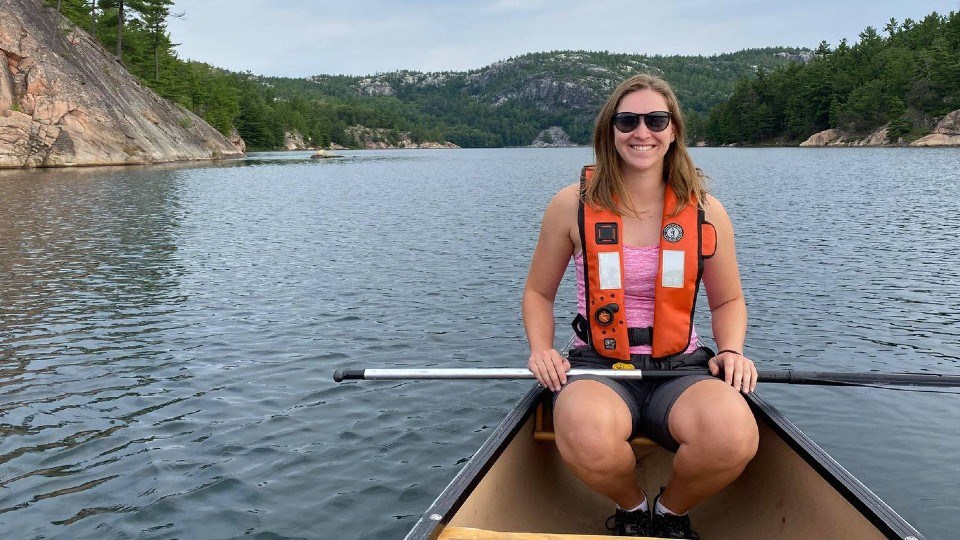A researcher at Sudbury’s Living with Lakes Centre is walking in director John Gunn’s footsteps in studying the recovery of acidified lakes damaged by the city’s smelter operations in the 1960s.
Once the largest point source of sulphur dioxide emissions in the world, the Sudbury region’s infamous black barren landscape became a benchmark for environmental devastation.
Thanks to a successful regreening program launched in 1978, the city was able to reduce its air pollution to less than five per cent of its historic high.
About 40 years later, a local master’s student is documenting the recovery of Killarney’s interior lakes as a result of this reduction.
“I’ve lived in Sudbury my whole life, and so I was always really familiar and passionate about the regreening program and restoration in general,” said Haley Moskal, a master’s student in biology at the Living with Lakes Centre.
“I knew I wanted to be a part of the Sudbury restoration story, so when I saw the opportunity at the centre, I applied. This led me to pursue my degree under the supervision of Dr. John Gunn and Dr. Brie Edwards.”
Gunn is the director of the Living with Lakes Centre and a Canada Research Chair for stressed aquatic systems.
Moskal, with the help of her field partner Genevieve Peck, is repeating a detailed biodiversity study that Gunn and his colleagues performed in Killarney Provincial Park from 1995 to 1997.
“I will be using the original site and sampling methods that were used within Killarney to assess the recovery of various indicator species, including littoral (or nearshore) fish, zoo plankton, arthropods, crayfish and mayflies,” she said.
“All of the Killarney lakes were damaged by acid deposition from the Sudbury smelter complex. The lakes had a really low pH, they were extremely clear, and many species were lost. Due to the massive investment in air pollution reduction, there has been significant biological and water recovery in Killarney. Nature is responding to the cleanup.”
Over a span of around two years, Moskal will visit up to nine lakes in the provincial park during the summer and fall months to document the presence or absence of these indicator species and perform water analysis.
“We’re going to compare our results to the original study, and we’re hoping to assess the temporal trends of recovery in the species from the historic conditions of acidification,” she said.
“We will also assess the current conditions of the Killarney lakes and any changes to the biology or chemistry that these lakes are experiencing.”
This research will be useful in the field of environmental restoration.
“It’s important to know how aquatic systems recover from the conditions of acidification, the level of recovery they will experience, and how long it takes,” said Moskal.
“We are looking at data over a 40-year recovery period – there’s a lot of data there and it’s a really long story.”
Throughout the summer, Moskal will be out in the field setting minnow and crayfish traps to study the lake’s littoral fish population. Because she is initially focusing on species presence or absence, she will be doing a live release.
Come fall, she will be dipnetting for benthos species and studying zoo plankton. As part of the project, she’s also on the lookout for invasive species because of the water’s proximity to Georgian Bay.
Moskal began her research in May, so it’s too soon to jump to conclusions, but things look positive from what she’s seen so far.
“It seems like things are in recovery for sure. We did George Lake last week, and we noticed a lot of bass in the water, and that’s actually one of the changes we’re looking for,” she said.
“Climate change is warming the lakes and so warm water species like bass are expanding their role and that could result in an ecosystem change.”
The lakes were also in a much earlier stage of recovery from acidification, she added, during the original study in the 1990s.
“The lakes are in a much later stage of recovery now. Interactions between species are really important at this stage of recovery,” she said.
“The biotic interactions between organisms that play a big role in the level of recovery of the lakes. The lakes are changing, and the biology is what’s driving the change. I didn’t know that going into it and I am really excited to learn more about that.”
Moskal has come to learn that it’s very difficult to define when exactly a lake can be deemed recovered, but by studying indicator species, scientists can get a good grasp on the health of the ecosystem.
“If there were no indicator species in the lake in the 90s and then we find them in the lake now, we can tell that it is recovering,” she said.
Of her experience working at the Living with Lakes Centre, Moskal said it’s a wonderful place to be.
“The experience has been really fantastic. I am really enjoying this project, and I love going out into the field. I love being a part of the work they do here, and I think this is what I want to do,” she said.
Colleen Romaniuk is a Local Journalism Initiative reporter at The Sudbury Star. The Local Journalism Initiative is made possible through funding from the federal government.
